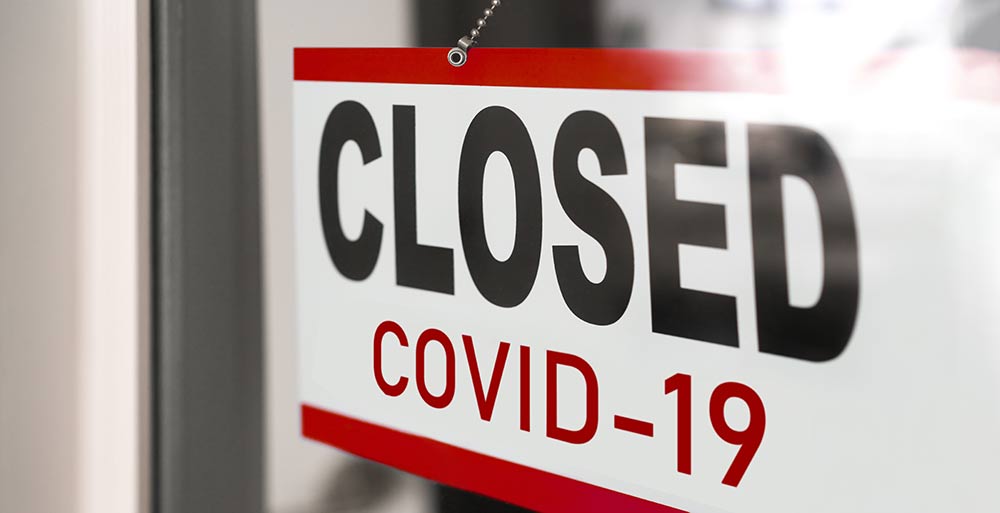How Churches of All Sizes Can Survive (Even Thrive) in a Post-Pandemic World.
Streaming other churches’ content is one way smaller churches can move from maintenance to missional mode
When the pandemic first hit, frantic shopping began. Most people went straight to big retailers—Walmart, Costco, and Amazon.
Stock market guru Jim Cramer voiced concern that only these behemoths would be left standing once the crisis finally fades. The little guys, already steadily losing market share, will have finally lost.
It makes you wonder about little churches. How will they fare in the COVID 19 era?

So far and overall, smaller churches ( < 100 in attendance) have been doing okay. Americans religious commitment has declined in the past ten years, though not so drastically as some headlines suggest.
Many more American adults now say they are religiously unaffiliated or “nothing in particular.” But this increase in “nones” (from 17% in 2009 to 26% in 2019, according to Pew Research Center) can be largely attributed to a corresponding drop in “nominals”—that is, people with weak religious ties who were never regular churchgoers in the first place.
The main cause for dying churches and dwindling denominations has not been religious decline, but rather religious mobility. In economic terms, the marketplace did not collapse; it got much more competitive.
Comparison shopping has clearly hurt older liberal Protestant denominations, which have lost many members in recent decades, while some newer conservative Pentecostal groups have gained.
People shopping around have also been drawn toward megachurches, which are able to offer a number of high quality services. The biggest losers have been mid-sized congregations.
But many smaller churches have held their own by maintaining a niche. “Pastor Joe or Jane is not the world’s best preacher,” their members may agree. “But that’s okay. What we have going for us is intimacy.
“Our church is like family, close and connected—not socially distant like some of those big churches. We specialize in warm greetings, hearty hugs, and covered dish potlucks. We like to hold hands and pray.”
Oops.
What will the pandemic do to smaller churches whose comparative advantage has been a low-tech, high-touch approach to ministry? Will just a handful of mega churches be left standing—the Amazon, Walmart, and Costco equivalents?
Not necessarily. Depending on how they respond, particular churches in all size brackets can experience renaissance, not demise. And smaller churches will have a unique opportunity to thrive in coming months and years.
So much is uncertain, but one thing seems clear: the social distancing rules were swift and dramatic in their impact, but the return to “normalcy” is going to be slow and jerky. Churches are feeling their way into new territory.
Following are some developments we can anticipate, along with guidelines for surviving (even thriving) in coming months and years.
First, all churches will be competing more than ever against activities that are not church. When churches were shuttered by the virus and forced online, many regular worshipers followed their leaders into cyberspace. But many others did not. One third of regular worshipers were never going online to watch services, according to research reported by National Public Radio in April, 2020.

Some churchgoers may decide the habit of going to Sunday worship is not worth resuming. They will be eager to get out and do others activities on Sundays, which don't involve sitting near people or the prospect of catching a stray cough or sneeze.
Others, however, will return to church services as never before. Like combatants coming home from battle, or like persons stranded on an ocean raft craving food and fresh water, they will be eager for worship and fellowship.
In other words, we can picture the devoted becoming more zealous than ever, while those with weaker ties decide to make even fewer if any appearance—thus a quickening of the trend already take place: increasing nones, decreasing nominals.
Recommendation: All churches should be able to answer this question: What makes church—as both community and activity—so important that people dare not miss it?
Second, most churches will be facing financial hardship. Financial giving has declined, because many people connect giving with to weekly attendance. Churches are currently faring better financially if their members were already accustomed to online giving and/or tithing. Yet even in these cases, giving is based on a percentage of incomes, and many incomes have also declined with spiking unemployment.
Recommendation: Explain to people all the vital things they are supporting, beside Sunday morning worship—and make sure these things really are vital.
The next items concern Protestant churches the most. In the competition for people’s time and money, they are competing not only against the secular world, but each other. (See article on Church Cooperation on this web page.)
“
Now is the time for small churches to transition from maintenance mode to missional mode.
”
Third, large churches and mega churches can expect to see an increase in viewership. The pandemic plays to their strongest suit—captivating preaching, along with good streaming and publicity capabilities.
The 1980s and 90s saw the rise of televangelism, which meant some people decided to stay home and watch church. In 2020, all Christians were forced into that position. Catholics universally could watch the Pope celebrate Mass in a lonely St. Peter’s Square, whereas Protestants were confronted with a plethora of other Internet options.
“I am watching a great and beautiful service by Pastor Jentezen Franklin. Thank you!” tweeted Donald J. Trump on March 15.
“I will be tuning into Pastor @greglaurie at @harvestorg Church in Riverside, California tomorrow at 11:00 A.M. Eastern,” the President announced on April 4.
Like the President, many people were probably sampling different preachers, thus giving large churches a chance to extend their reach. The challenge will be converting watchers into ongoing disciples of Jesus Christ.
Recommendation: Tell viewers how to find a local church where they can go (once the crisis fades) to meet believers and grow in Christ. It doesn’t even need to be a satellite campus of the large church.
Fourth, mid-sized churches have a tough road ahead. Most lack the preaching power and technological prowess of large churches. Many also lack the family feel of small churches.
But mid-sized churches don’t need to be neither fish nor foul. Their comparative advantage is an ability to offer more activities than smaller churches, plus closer community than a megachurch.
Recommendation: Utilize relatively simple technology—e.g., texting prayer concerns, Zoom Bible studies or small group check-ins, even old-fashioned phone calls. Mid-sized churches can stream their services, or they can invite people to watch “recommended content” already uploaded. This content can even come from another church or parachurch group.
Fifth, small churches have a chance to shine the most in coming months and years. That is, if they are willing to rethink church.
Now is the time for small churches to transition from maintenance mode to missional mode—and to do so by separating content from community.
Missional mode means the church is not just a building and budget, but instead a body of believers. The church is not a place people drive to, but a community of people who are driven—by the love of God—to go into all the world, teaching, baptizing, and doing good things in Jesus’ name. In short, the church is focused on God’s mission.

Missional has been a buzz word for years, but also an unrealized possibility for most smaller churches—because most smaller churches are stuck. They are stuck in maintenance mode, which means that most of the church’s money goes into hiring a pastor, and much of the pastor’s energy goes into preparing sermons and other content.
But why? Sermons and other content are already richly available and accessible via the Internet. People knew this before. But people who were in quarantine have had an opportunity to explore the breadth and depth of this content, created by Christians of all nations and theological persuasions.
So here’s one idea.
Recommendation: Rethink what the church’s mission could be if more content was streamed, so that more focus was given to fostering community.
Pastor (or bi-vocational, part-time pastor) Joe or Jane could spend a lot more time in prayer, community care, and outreach if freed from the burden of having to prepare a message each week. People are already finding good content on their own. What if the best of what they found was shared with the rest of the church each Sunday morning?
Paul tells the church in Corinth: “When you come together, each one has a hymn, a lesson, a revelation, a tongue, or an interpretation” (14:26). What if we add, “or a streamed sermon” to that list?

Yes, there would be licensing issues, but churches already deal with those when it comes to music. Yes, there is tremendous benefit to a live sermon, provided it is good—but honestly, how often is that really case in a small church?
In many small churches, the pastor is called the preacher. Certainly if the pastor feels the call, has the gift—if the anointing falls—then he or she should preach away.
Small churches with great preaching usually become bigger churches.
But maybe, just maybe, Protestants have sometimes over-emphasized the sermon, while neglecting other ways of being “in the Word,” such as a small group Bible study that can both edify each person and foster communal relationships.
Recommendation: Rethink as well what kind of space is really needed to fulfill the church’s mission.
People stuck at home hopefully found they were able to meet God in a small space. Stone buildings and steeples can be wonderful, but not every church needs them, nor does God require them to be present. The first Pentecostal church met in in a rented Upper Room.
Often smaller churches close down when they can no longer afford to maintain their outsized buildings. But instead of shutting down, why not consider downsizing, even by moving into a living room?
The house church is an old, Biblical idea that has gotten more attention recently. Pre-Pentecost, the church “numbered about a hundred and twenty” (Acts 1:15), which may be a fine size for a Post-Pandemic church today. Or even smaller. We read later in Acts, as well as in Romans and Colossians, about smaller churches that meet in homes.

We don't know everything about these house churches, but we can easily imagine they had close community that was a witness to the watching world. As the song says, “they will know we are Christians by our love, by our love.” We can also imagine the content of church meetings varied. Sometimes Peter stood up and preached. Sometimes a letter from Paul was read aloud.
But never was all their energy consumed with figuring out how to maintain the building or repave the parking lot. They had bigger things to worry about—like lions, and a lost world where people were dying.
Not totally unlike the position we are in today.

